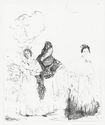
19th, 20th & 21st Century Fine Prints
707-546-7352 · fax 707-546-7924 · web: www.annexgalleries.com · email: artannex@aol.com
Ignacio Zuloaga Biography
Ignacio Zuloaga
Spanish
1870–1945
Biography
Ignacio Zuloaga y Zabaletta was born on July 26, 1870 in Eibar, near Bilbao, Spain. The son of a successful metalworker, Zuloaga was a largely self-taught artist who learned to paint by copying Old Masters in the Prado Museum in Madrid. Beginning about 1890, he split his time between Paris and Spain In Paris he became acquainted with the artists Paul Gauguin, Edgar Degas and Auguste Rodin but, despite his contact with these French masters his main influences were his Spanish countrymen; El Greco, Velazquez and Goya.
Inspired by a visit to the Andalusia region of Spain in 1892, Zuloaga began to focus on subject matter from Spanish culture and folklore, such as bullfighters, peasants, and dancers. He used earthen colors almost exclusively and often placed his figures against dramatic landscapes. Zuloaga began to achieve international success with the painting Daniel Zuloaga and His Daughters, which was exhibited in 1899 and purchased by the French government for the Luxembourg Museum in Paris. About 1907 he became a popular society portraitist, an aspect of his career that brought him considerable wealth.
After spending much of his career working in Paris, Zuloaga settled permanently in Spain in 1924. His paintings were exhibited in a highly successful one-man show in New York City in 1925. He was awarded the grand prize for painting at the Venice Bienalle in 1938.
In Spain Zuloaga was committed to the Nationalist faction during the Spanish Civil War and the Spanish State of the dictator Francisco Franco, whose portrait he painted in 1940. Ignacio Zuloaga died in Madrid, Spain on October 31, 1945

